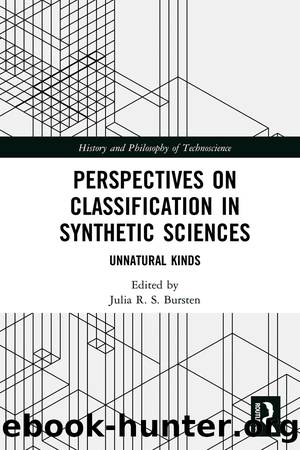Perspectives on Classification in Synthetic Sciences by Bursten Julia R. S.;

Author:Bursten, Julia R. S.; [Неизв.]
Language: eng
Format: epub
Publisher: Taylor & Francis (CAM)
Published: 2019-06-09T20:00:00+00:00
* * *
Abstraction kind–making
Modularity part–making
Standardization part–making and kind–making
Taking this suggestion seriously, what does this mean for the work of synthetic biology practitioners, or scientists more generally? And more pointedly, how are these principles used within the work of scientists? Scientists rely on socially accepted protocols as sets of explicit and implicit rules of action. However, the action of individual agents within the social group of scientists is not the work of idealized decision-makers, but seems to be biased on individuals whose beliefs are not entirely self-generated. Grene’s (1966) view seems underpinned by exactly this sort of agent-based view. In so doing, it investigates a perspective where action is always from a standpoint, but that the standpoint is located in social networks of knowledge-producing practices. It is a place from which the agent acts that appears to be itself a precondition for personal action.
The social nature of scientific practice that Longino suggests also emphasizes the intimate connection between the character of inquiry and the goals of individual scientists. As such, it is also prerequisite for what she refers to as “social cognition” – the idea that scientific inquiry is not simply an individual pursuit but an epistemic activity relying on the intersubjectivity of critical dialogue within scientific study (Longino, 1990). In doing so, she follows Grene (1966, 1985) in fleshing out the nature of what it means to be a social enterprise and what Chang (2004, 2012) later identifies as a system of practice. According to Chang, the search for an agent-free or context-free set of categories is simply one that is ill-founded in philosophy:
A system of practice is formed by a coherent set of epistemic activities performed with a view to achieve certain aims …[A]s with coherence of each activity, it is the overall aims of a system of practice that define what it means for the system to be coherent. The coherence of a system goes beyond mere consistency between the propositions involved in its activities: rather, coherence consists in various activities coming together in an effective way toward the achievement of the aims of the system.
(Chang, 2012, p. 16)
Download
This site does not store any files on its server. We only index and link to content provided by other sites. Please contact the content providers to delete copyright contents if any and email us, we'll remove relevant links or contents immediately.
| Anatomy | Animals |
| Bacteriology | Biochemistry |
| Bioelectricity | Bioinformatics |
| Biology | Biophysics |
| Biotechnology | Botany |
| Ecology | Genetics |
| Paleontology | Plants |
| Taxonomic Classification | Zoology |
Sapiens: A Brief History of Humankind by Yuval Noah Harari(13054)
The Tidewater Tales by John Barth(12030)
Do No Harm Stories of Life, Death and Brain Surgery by Henry Marsh(6337)
Mastermind: How to Think Like Sherlock Holmes by Maria Konnikova(6236)
The Thirst by Nesbo Jo(5786)
Why We Sleep: Unlocking the Power of Sleep and Dreams by Matthew Walker(5644)
Sapiens by Yuval Noah Harari(4538)
Life 3.0: Being Human in the Age of Artificial Intelligence by Tegmark Max(4509)
The Longevity Diet by Valter Longo(4446)
The Rules Do Not Apply by Ariel Levy(3906)
The Immortal Life of Henrietta Lacks by Rebecca Skloot(3826)
The Body: A Guide for Occupants by Bill Bryson(3802)
Why We Sleep by Matthew Walker(3773)
Animal Frequency by Melissa Alvarez(3755)
Yoga Anatomy by Kaminoff Leslie(3702)
Barron's AP Biology by Goldberg M.S. Deborah T(3632)
The Hacking of the American Mind by Robert H. Lustig(3580)
All Creatures Great and Small by James Herriot(3517)
Yoga Anatomy by Leslie Kaminoff & Amy Matthews(3396)
